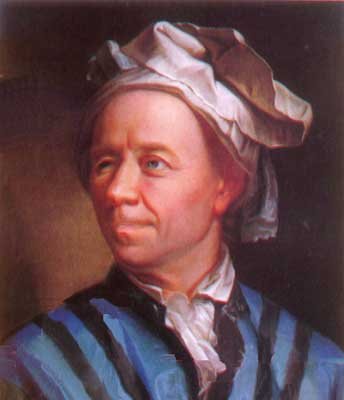- About MAA
- Membership
- MAA Publications
- Periodicals
- Blogs
- MAA Book Series
- MAA Press (an imprint of the AMS)
- MAA Notes
- MAA Reviews
- Mathematical Communication
- Information for Libraries
- Author Resources
- Advertise with MAA
- Meetings
- Competitions
- Programs
- Communities
- MAA Sections
- SIGMAA
- MAA Connect
- Students
- MAA Awards
- Awards Booklets
- Writing Awards
- Teaching Awards
- Service Awards
- Research Awards
- Lecture Awards
- Putnam Competition Individual and Team Winners
- D. E. Shaw Group AMC 8 Awards & Certificates
- Maryam Mirzakhani AMC 10 A Awards & Certificates
- Two Sigma AMC 10 B Awards & Certificates
- Jane Street AMC 12 A Awards & Certificates
- Akamai AMC 12 B Awards & Certificates
- High School Teachers
- News
You are here
Napier's e - e in Leonhard Euler's Introductio
1745 (1748) To say that Leonhard Euler (1707-1783) was a prolific mathematician is the height of understatement. He worked in almost every branch of mathematics of his time, as well as natural philosophy (the term at that time for physics and other natural sciences). He has 866 mathematical and scientific works to his credit [6]. The publication of Euler’s Opera Omnia was begun in 1911 and is still underway with 76 volumes already available. When finished, at least 29 volumes will be on mathematics, the remainder dealing with mechanics, astronomy, physics and other topics [2]. He is known for his extensive, though at times footloose and fancy free, work in infinite series. He is also known for giving us many of our modern mathematical notations, such as f(x) and i. In particular, Euler is credited with giving us e for 2.71828… In fact, he was the first to work extensively with this constant and calculated it to 23 decimal places [7, 8]. Much of his work using e appears in the first book of his very influential two volume treatise Introductio in Analysin Infinitorum (Introduction to Analysis of the Infinite) [7], written in 1745 and published in 1748.

Leonhard Euler
In the course of discussing the series expansion of logarithmic expressions in section 122 of the Introductio, Euler gives the following expansion for an arbitrary base a [7]. (Notice that he wrote it in the way we would today, except that by using log, he intends the log to any base, not necessarily base 10.):
|
$$\log(1+x)={1\over k}\left({x\over 1}-{x^2\over 2}+{x^3\over 3}-\cdots\right)$$
|
After exploring this expansion for values of a such as 1 and 10, Euler then determines a so that k = 1. Using the expansion for a he had given earlier (section 116):
|
$$a=1+{k\over 1}+{k^2\over 1\cdot 2}+{k^3\over 1\cdot 2\cdot 3}+\cdots,$$
|
he obtains:
|
$$a=1+{1\over 1}+{1^2\over 1\cdot 2}+{1^3\over 1\cdot 2\cdot 3}+\cdots$$
|
From this he states that a=2.71828182845904523536028… He then goes on to say [7]:
For the sake of brevity …we will use the symbol e, which we denote the base of the natural or hyperbolic logarithms, which corresponds to the value k = 1, and e represents the sum of the infinite series
|
$$1+{1\over 1}+{1\over 1\cdot 2}+{1\over 1\cdot 2\cdot 3}+\cdots$$
|
Thus Euler gave us the formula
|
$$e=\sum_{n=0}^{\infty}{1\over n!}={1\over 0!}+{1\over 1!}+{1\over 2!}+\cdots,$$
|
and is credited with the notation e.
In the Introductio, Euler also uses the term “natural logarithms” and computes the natural logarithms of the integers 1,2,3,…,10 to 25 decimal places. As far as we know, the term “natural logarithm” was first used by Nicolaus Mercator (1620-1687) in his 1668 Logarithmotechnia [10]. In this work, Mercator uses the binomial theorem to expand ln(1+x) to get the “Mercator series” x/1 - x2/2 + x3/3 - x4/4 + ... [11]. As a side note, in the Introductio we also see the first formal definition of a function as well as the notation f(x) [2].
The Introductio is usually cited as the first place that e appears. And, as urban legend would have it, many people assume Euler chose e for “Euler”. However, this is not the case. Euler’s modesty would not have allowed him such pomp. In all likelihood, he chose e to represent “exponential” or simply because it was the next letter in the alphabet not already used widely for another purpose. But in point of fact, Euler had actually introduced the notation e earlier.
Amy Shell-Gellasch (Beloit College), "Napier's e - e in Leonhard Euler's Introductio," Convergence (April 2010), DOI:10.4169/loci003209




